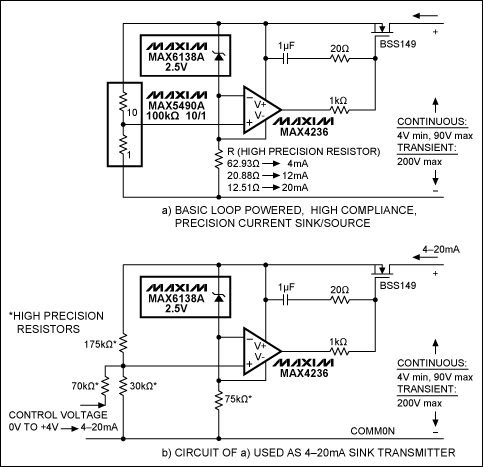

Precision current-transmitter/source-sink calibrator has wid
模拟技术
描述
Based on a precision op amp (MAX4236), this loop-powered, high-compliance, precision current sink (or source) can be modified for use as a 4–20mA sink transmitter.
A similar version of this article appeared in the March 24, 2009 issue of ED magazine.
Many industrial I&C applications use analog current loops as the physical link for measurements and actuator control. Current loops in the 4–20mA and 5–50mA ranges are typical, along with others less common. Most popular and still surviving is the 4–20mA standard.
Loop accuracy depends on the transmitter's ability to transform the sensor signal to a current, and on the stability of the current-transfer function (measured at the receiver) with respect to temperature, physical length of the loop, stability of the loop-supply voltage, and other uncertainties that appear as the hardware deteriorates with age.
Besides linearity and stability of its current-transfer function, the transmitter output of a current-loop circuit must provide a large dynamic impedance, to minimize the influence of loop voltage (at the transmitter terminals) on output current. The maximum voltage tolerated at the terminals is also important. The higher the better, because the electromagnetic environment in industrial plants is not always benign. The minimum allowed transmitter-terminal voltage, which determines the maximum loop length for a given wire gauge (or the minimum wire cross-section needed for a given loop run) should be minimized at the same time.
The transmitter circuit of Figure 1 provides a very high output impedance (108 to 109 ohms) and a wide compliance range (4V to 90V). The lower limit is set by the amplifier's minimum operating voltage, and the upper limit by the power dissipation allowed in the output device (an n-channel depletion MOSFET) at the 20mA high end of the current range. For brief periods of 20ms or so, the maximum voltage can go as high as 200V.

Figure 1. This basic loop-powered, high-compliance, precision current sink (or source) (a) can be modified for use as a 4–20mA sink transmitter (b).
The basic circuit (Figure 1a) is configured as a loop calibrator. With the components shown, it can operate with 10-bit accuracy from 0°C to 85°C, plus the added uncertainty of resistor R. Having only two terminals, it can operate as either a sinking or a sourcing calibrator.
In Figure 1b, this circuit is modified for use as an interface to an open-loop current sensor with 0V-to-4V output range. Accuracy of the transfer function in this case depends on the reference (MAX6138) and the precision of the resistors in the interface network. Because the reference equipotential (ground) is shared by the instrument and the transmitter, you should exercise care not to create ground loops in the circuit implementation.
The MAX4236 input characteristics (20µV maximum offset and 2µV/°C offset temperature drift), its high gain (110dB), and its ability to operate with inputs down to the negative rail, makes negligible the influence of all other components. To achieve higher accuracy, therefore, you must use standard trimming techniques that employ either mechanical or integrated-circuit adjustment potentiometers.
The MAX4236 ability to operate with input voltages down to the negative rail is essential for circuit accuracy, because it allows the amplifier's operating current to be forced through the output current-sense resistor, where it becomes a part of the output current under circuit control. Further information, including full data sheets for the MAX4236, MAX5490, and MAX6138 is available at www.maxim-ic.com.
- 相关推荐
- 热点推荐
- Precision
- current
- compliance
-
OPA548 source正常输出,sink无法工作怎么解决?2024-08-02 389
-
Bipolar Current Source2011-09-06 2054
-
为什么使用ucpd1作为source时连接sink设备不会发送source capabilities呢2022-12-06 412
-
XTR105 pdf datasheet (4-20mA, two-wire current transmitter)2008-12-19 1823
-
AD5422,pdf datasheet (Current2009-09-18 455
-
ADR127,datasheet,pdf(Precision2009-10-23 769
-
TPS51100,PDF(3-A SINK/SOURCE D2010-10-12 604
-
TPS51200-Q1,pdf(Sink/Source DD2010-10-20 517
-
Precision Current Source is So2009-04-29 2518
-
精密电流源:Precision Current Source2009-05-16 5865
-
DS4426 Low-cost, quad sink/sou2009-08-27 975
-
Precision constant-current sin2010-08-21 1667
-
ADR441ACHIPS: Ultralow Noise, LDO, XFET, Voltage Reference with Current Sink and Source Data Sheet2021-01-29 647
-
MAX40080: Precision, Fast Sample-Rate, Digital Current-Sense Amplifier Data Sheet MAX40080: Precision, Fast Sample-Rate, Digital Current-Sen2023-10-16 62
全部0条评论

快来发表一下你的评论吧 !

